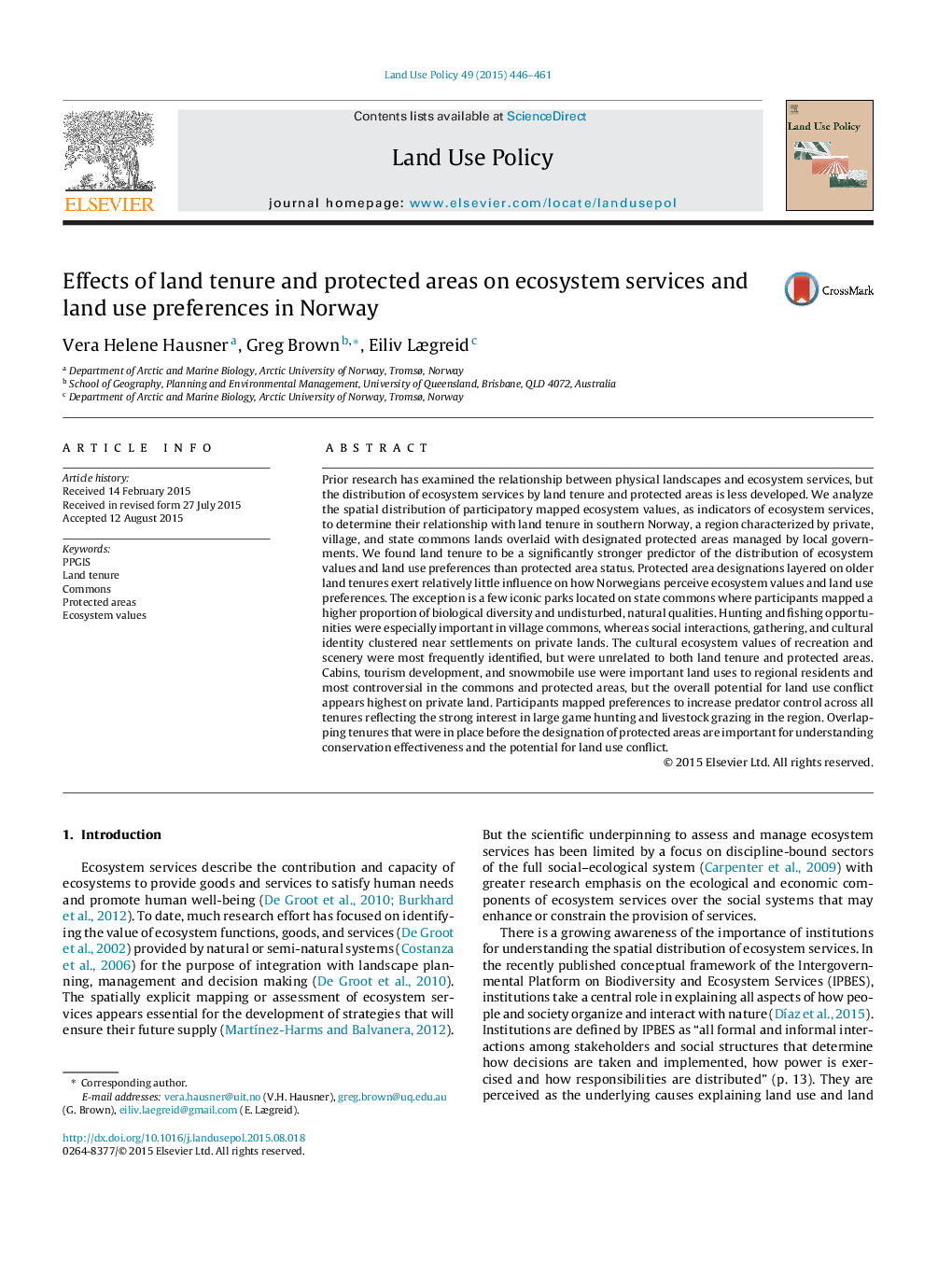| کد مقاله | کد نشریه | سال انتشار | مقاله انگلیسی | نسخه تمام متن |
|---|---|---|---|---|
| 6547792 | 160102 | 2015 | 16 صفحه PDF | دانلود رایگان |
عنوان انگلیسی مقاله ISI
Effects of land tenure and protected areas on ecosystem services and land use preferences in Norway
ترجمه فارسی عنوان
اثرات مالکیت زمین و مناطق حفاظت شده بر خدمات اکوسیستم و ترجیحات کاربری زمین در نروژ
دانلود مقاله + سفارش ترجمه
دانلود مقاله ISI انگلیسی
رایگان برای ایرانیان
کلمات کلیدی
ترجمه چکیده
تحقیقات پیشین ارتباط بین مناظر فیزیکی و خدمات اکوسیستمی را مورد بررسی قرار داده است، اما توزیع خدمات اکوسیستم با استفاده از مالکیت زمین و مناطق حفاظت شده کمتر توسعه یافته است. ما تجزیه و تحلیل توزیع فضایی ارزش های اکوسیستم نقشه برداری مشارکتی، به عنوان شاخص های خدمات اکوسیستم، برای تعیین رابطه آنها با مالکیت زمین در جنوب نروژ، یک منطقه مشخص شده توسط زمین های مشترک خصوصی، روستا و دولتی پوشش داده شده با مناطق حفاظت شده تعیین شده توسط دولت های محلی. ما دریافت کردیم که مالکیت زمین به طور قابل توجهی قوی تر از توزیع مقادیر اکوسیستم و ترجیحات کاربری زمین نسبت به وضعیت منطقه حفاظت شده است. تعاریف حفاظت شده در سطح زمین در زمین های قدیمی تر تاثیر چندانی بر نفوذ نروژی ها در ارزش های اکوسیستم و تنظیمات استفاده از زمین ندارد. استثنا چند پارک نمادین واقع در شایع های دولتی است که در آن شرکت کنندگان نسبت بیشتری نسبت به تنوع زیستی و ناهنجاری و کیفیت طبیعی خود را نشان می دهند. فرصت های شکار و ماهیگیری به ویژه در روستاهای عمومی اهمیت دارد، در حالی که تعاملات اجتماعی، جمع آوری و هویت فرهنگی در نزدیکی شهرک ها در زمین های خصوصی قرار دارد. ارزشهای اکوسیستمی فرهنگی تفریحی و مناظر بیشتر شناسایی شدند، اما با هر دو زمین و مناطق حفاظت شده ارتباطی نداشتند. کابین ها، توسعه گردشگری و استفاده از وسایل نقلیه برفی استفاده های مهم زمین برای ساکنین منطقه ای بود و بیشتر بحث برانگیز در مناطق مشترک و حوزه های حفاظت شده بود اما پتانسیل بالقوه مناقشه در استفاده از زمین در سرزمین های خصوصی بیشتر دیده می شود. شرکت کنندگان ترجیحات خود را برای افزایش کنترل شکارچی در تمام مراحل، منعکس کننده علاقه شدید به شکار بازی های بزرگ و حیوانات دام در منطقه می باشند. برای درک اثربخشی حفاظت و بالقوه منازعه در زمینه استفاده از زمین، تعاریف همپوشانی که در قبل از تعیین مناطق حفاظت شده وجود داشت، مهم هستند.
موضوعات مرتبط
علوم زیستی و بیوفناوری
علوم کشاورزی و بیولوژیک
جنگلداری
چکیده انگلیسی
Prior research has examined the relationship between physical landscapes and ecosystem services, but the distribution of ecosystem services by land tenure and protected areas is less developed. We analyze the spatial distribution of participatory mapped ecosystem values, as indicators of ecosystem services, to determine their relationship with land tenure in southern Norway, a region characterized by private, village, and state commons lands overlaid with designated protected areas managed by local governments. We found land tenure to be a significantly stronger predictor of the distribution of ecosystem values and land use preferences than protected area status. Protected area designations layered on older land tenures exert relatively little influence on how Norwegians perceive ecosystem values and land use preferences. The exception is a few iconic parks located on state commons where participants mapped a higher proportion of biological diversity and undisturbed, natural qualities. Hunting and fishing opportunities were especially important in village commons, whereas social interactions, gathering, and cultural identity clustered near settlements on private lands. The cultural ecosystem values of recreation and scenery were most frequently identified, but were unrelated to both land tenure and protected areas. Cabins, tourism development, and snowmobile use were important land uses to regional residents and most controversial in the commons and protected areas, but the overall potential for land use conflict appears highest on private land. Participants mapped preferences to increase predator control across all tenures reflecting the strong interest in large game hunting and livestock grazing in the region. Overlapping tenures that were in place before the designation of protected areas are important for understanding conservation effectiveness and the potential for land use conflict.
ناشر
Database: Elsevier - ScienceDirect (ساینس دایرکت)
Journal: Land Use Policy - Volume 49, December 2015, Pages 446-461
Journal: Land Use Policy - Volume 49, December 2015, Pages 446-461
نویسندگان
Vera Helene Hausner, Greg Brown, Eiliv Lægreid,
